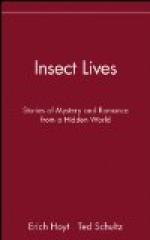Attention has already been drawn to the contrast in outward form between a butterfly and its caterpillar. As in the case of dragon-fly or may-fly, the larval period is essentially a time for feeding and growth, and during this period the larval cuticle is cast four or five, in some species even seven or eight times. After each moult some changes in detail may be observable, for example in the proportions of the body-segments or their outgrowths, in the colour or the closeness of the hairy or spiny armature. But in all main features the caterpillar retains throughout its life the characteristic form in which it left the egg. From the tiny, newly-hatched larva to the full-fed caterpillar, possibly several inches in length, there is all along the same crawling, somewhat worm-like body, destitute of any outward trace of wings. When however the last larval cuticle has split open lengthwise along the back, and has been worked off by vigorous wriggling motions of the insect, the pupa thus revealed shows the wing-rudiments conspicuous at the sides of the body, and lying neatly alongside these are to be seen the forms of feelers, legs, and maxillae of the imago prefigured in the cuticle of the pupa (fig. 1 e). The pupa thus resembles the imago much more closely than it resembles the larva; even in the proportions of the body a relative shortening is to be noticed, and the imago of any insect with complete transformation is reduced in length as compared with the full-fed larva. Now these wings and other structures characteristic of the imago, appear in the pupa which is revealed by the shedding of the last larval cuticle. From these facts we infer that the wing-rudiments must be present in the larva, hidden beneath the cuticle; and until the last larval instar, not beneath the cuticle only, but growing in such-wise that they are hidden by the epidermis. For if they were growing outwardly the new cuticle would be formed over them, so that they would be apparent after the next moult. But it is clear that only in the pupa, forming beneath the cuticle of the last larval instar, can they grow outwards.
Anatomical study of the caterpillar at various stages verifies the conclusions just drawn from superficial observation. A hundred and fifty years ago P. Lyonet in his monumental work (1762) on the caterpillar of the Goat Moth (Cossus) detected, in the second and third thoracic segments, four little white masses buried in the fat-body, and, while doubtful as to their real meaning, he suggested that their number and position might well give rise to the suspicion that they were rudiments of the wings of the moth. But it was a century later that A. Weismann in his classical studies (1864) on the development of common flies, showed the presence in the maggot of definite rudiments of wings, and other organs of the adult—rudiments to which he gave the name of imaginal discs. We will recur later to these transformations of the Diptera. For the present, we pursue our survey of changes in the life-history of the Lepidoptera and can take to guide us the excellent researches of J. Gonin (1894).




